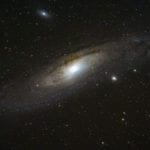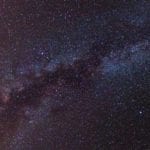A logical thinker and always ready for a challenge, Victoria Kaspi chose to pursue physics when she was studying in CÉGEP in Québec. “I always liked math,” she recalls, “but choosing which field of science to pursue was a process of elimination for me. I could tell chemistry and biology were not my calling, but I loved the highly mathematical nature of physics.”

Kaspi completed her undergraduate degree in physics at McGill University. During the summers of her studies, she worked at Carleton University through the NSERC Undergraduate Student Research Award program where she got her first taste of research. “I loved it,” she says, “I always really liked the nitty gritty of research, having a great idea and pursuing it.”
From then on, Kaspi continued with physics. She chose her field of study within physics based again on logical reasoning. “I liked working with smaller research groups, I enjoy close collaborations, getting to know colleagues as friends.” Radio astronomy fit the bill: a field of physics that involves analyzing the radio waves given off by celestial objects in our universe.
Kaspi completed her PhD at Princeton University focusing on pulsars. “Pulsars are rotating neutron stars,” says Kaspi. “When giant stars in our Universe reach the end of their life and explode in a supernova, the remnants of the explosion are very dense objects called neutron stars, and rotating neutron stars are pulsars. They get their name from the fact that they appear to give off pulses of light when observed through a telescope.”
She goes on to explain that “pulsars have very strong magnetic fields [that] cause beams of particles, which give off light, to be sent out along the north and south poles of the star. As pulsars rotate, if they are aligned just right with the Earth, we can see “pulses” of light when we observe them, similar to seeing the pulses of a lighthouse on the sea.”
During her PhD, Kaspi studied the timing between pulses for 106 pulsars in the southern hemisphere using the Parkes Radio Telescope in New South Wales, Australia. In her thesis, entitled Applications of pulsar timing, Kaspi drew conclusions about what these timings might imply about the pulsars’ associations with nearby supernova remnants and other celestial bodies. Her work with Nobel Laureate Joseph Taylor also laid a foundation for the potential detection of gravitational waves with millisecond pulsars, a major international astrophysical initiative today.
After finishing her PhD, Kaspi took a step that would go on to shape the rest of her career. “After my PhD, it was a really good time to go into the field of X-ray telescopes,” she says. “There was a revolution in X-ray astronomy and I saw an opportunity. It was risky and a big change for me, but in a good way.”
Dr. Kaspi knew this revolution in X-ray astronomy was on the horizon because she always kept well informed of where different fields of physics were heading. “I went to a lot of seminars and interacted with many different people,” she says. “If I had to give some advice to young scientists, it would be to go to conferences, talk to scientists, you never know what might come your way. Be open to interdisciplinarity and have a broad mind.”
The risk paid off. Today, Kaspi is one of the world’s leading experts in the field of X-ray astronomy and has received many prestigious awards for her research achievements including the 2016 NSERC Gerhard Herzberg Gold Medal for Science and Engineering, the 2015 Killam Prize, the 2013 Peter G. Martin Award of Canadian Astronomical Society, and a 2013 Queen Elizabeth II Diamond Jubilee Medal.
Kaspi has held research and teaching positions at Princeton University, the California Institute of Technology, NASA’s Jet Propulsion Laboratory, the Massachusetts Institute of Technology, McGill University, and the Canadian Space Agency. Her research interests have remained focused on neutron stars, specifically studying their timing, origin and evolution, their relationships with supernovae, and the mechanics of binary systems (i.e., two neutron stars close together). She has recently refocused her efforts again to studying a new astrophysical puzzle called Fast Radio Bursts. These are mysterious bursts of radio waves coming from far outside the Milky Way, but of unknown origin.
She is now a Professor in the Physics Department at McGill University and Director of the McGill Space Institute. The objective of the institute is to “bring together different areas of space related research across the university.” Among its goals is space-related research excellence through interdisciplinarity among its members and sharing the Institute’s science with many audiences, including the public. “I feel strongly about people from different areas interacting,” says Kaspi, “many synergies bring about interesting conversation and research.”
Kaspi is still deeply involved with the research she loves but in a different way than she used to be. Now, much more of her time is dedicated to educating students. She has supervised a total of more than 90 projects of undergraduate students, graduate students, and post-doctoral fellows, helping a new generation rise up in the research world.
When asked whether she misses getting her hands dirty in the lab, Kaspi laughs and says, “Yes, I do miss the nitty gritty of research, my students do that more than I do now…But it’s fulfilling to see the students do well, and that’s the way it should be.”




